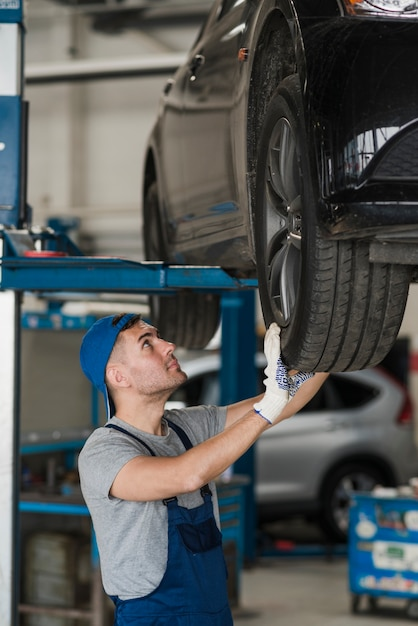What to Check Immediately After Hitting a Big Pothole
- web service
- Jul 24
- 4 min read
It happens in a split second.
You're cruising along and—BAM!—you hit a massive pothole.
Your stomach drops.
Your car rattles.
And suddenly, you’re wondering: What just broke?
You’re not alone. According to AAA, pothole damage costs U.S. drivers over $15 billion a year. Ignoring it can turn a quick fix into a costly automotive repair. That’s why checking your car right after is smart and can save you hundreds.
Here’s your quick, practical pothole damage checklist.
1. Check Your Tires First
Your tires take the first hit—literally. Look closely for:
· Bulges in the sidewall
· Cracks or gashes in the rubber
· Loss of air pressure
If you notice any of these, don't wait. A tire blowout could happen at highway speeds, and that's dangerous.
Pro Tip: Always keep a small tire pressure gauge in your glove box. It could spot slow leaks early.
2. Inspect Your Wheels and Rims
Potholes love to bend, crack, and warp rims. Even slight bends can cause big problems over time. After a pothole hit:
· Look for visible dents or bends.
· Feel for vibrations when driving.
Bent rims can lead to slow tire leaks and uneven wear, meaning even more visits to your local auto repair shop.

3. Pay Attention to Your Steering
If your steering feels "off" after hitting a pothole, trust your gut. Common symptoms include:
· Pulling to one side
· The steering wheel feels crooked
· Difficulty staying straight
These could point to suspension or wheel alignment issues. Both can get worse (and more expensive) fast.
Did You Know? Misaligned wheels can reduce your tires’ lifespan by up to 30%.
4. Listen for Unusual Noises
Hearing clunks, squeaks, or rattles? That’s your car asking for help. Strange noises can mean:
· Broken shocks or struts
· Loose suspension parts
· Damage to your undercarriage
Any new sound after a pothole hit deserves a visit to a car mechanic.
5. Look Underneath the Car
Your car’s underbody isn’t just cosmetic. It protects vital parts like:
· Oil pan
· Transmission
· Exhaust system
· Suspension components
After a pothole impact:
· Look under the car for leaks, drips, or hanging parts.
· Check for scrapes, dents, or cracked covers.
If you spot anything suspicious, call your local auto repair shop right away.
6. Test Your Braking Response
Even slight damage can mess with your brakes. Signs of brake trouble:
· Longer stopping distances
· Brake pedal feels "soft" or spongy
Brake system damage can sometimes be connected to pothole hits, especially if you slammed your brakes trying to avoid it. If your brakes feel different, get them checked at a car mechanic ASAP.
7. Pay Close Attention Over the Next Few Days
Not all pothole damage shows up immediately. Watch for:
· Gradual steering drift
· Uneven tire wear
· Persistent vibrations
If you notice slow-developing symptoms, schedule a full inspection at a car repair shop known for automotive repair and mechanical checks.
Pro Tip: Getting a simple alignment check after a major pothole hit could save you from replacing tires prematurely.
8. Check for Dashboard Warning Lights
Modern cars are smart. If you hit a pothole and something’s wrong, a sensor may trigger a dashboard light. Common lights include:
· Tire Pressure Monitoring System (TPMS)
· Check Engine Light
· ABS (Anti-lock Braking System) warning
Don’t ignore these. Even if the car feels fine, an internal system could be struggling.

Why Pothole Damage is More Serious Than It Looks
Pothole hits might seem harmless at first glance. But they create hidden stresses deep inside your car’s structure. Unchecked issues can lead to:
1. Higher tire replacement costs
2. Suspension rebuilds
3. Expensive steering repairs
4. Loss of vehicle safety features
That’s why acting early matters. It’s not about being overly cautious—it’s about avoiding automotive repairs that could've been cheap if caught sooner.
How Often Does Pothole Damage Cause Serious Problems?
According to the American Automobile Association (AAA), 1 in 10 drivers has had to make serious repairs after encountering a pothole. Common fixes include tire replacements, bent wheel repairs, and suspension work, often costing $300–$1000 or more.
In short? That nasty jolt you felt could easily become a nasty dent in your wallet.
Quick Pothole Damage Checklist
Here's a simple checklist you can screenshot:
Tires (bulges, pressure, cuts)
Wheels/rims (bends, cracks)
Steering (pulling, vibrations)
Suspension (noises, looseness)
Undercarriage (leaks, damage)
Brakes (feel, response)
Warning lights (dashboard)
Monitor for changes over 3–5 days

Need Help After a Pothole Hit? Trust Platinum Wrench Auto Repair
Pothole Trouble? Let Platinum Wrench Handle It.
If you've hit a pothole and something feels off, don't wait for small damage to grow into a major headache. Our expert technicians at Platinum Wrench Auto Repair can inspect, diagnose, and fix it fast, saving you money down the road.
Affordable car mechanic services
Precision alignments and suspension repairs
Local auto repair shop you can trust
Book your pothole inspection today! Platinum Wrench Auto Repair—Keeping Pinellas Park drivers safe and confident on every mile.




Comments